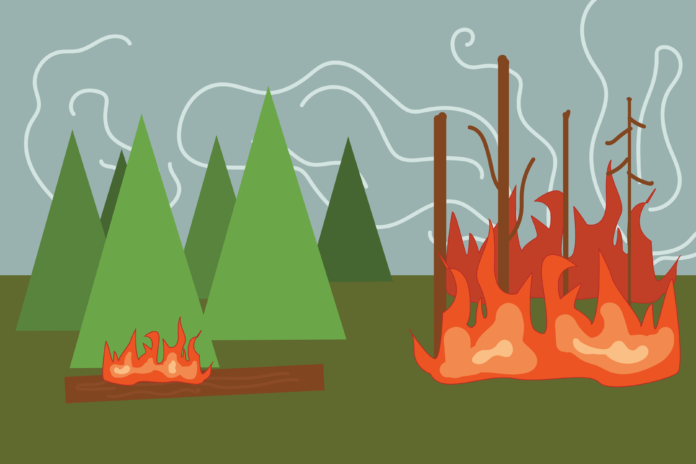High-severity wildfires are occurring much more frequently than these forests are accustomed to
By BRANDON NGUYEN — science@theaggie.org
A UC Davis study published in the journal Ecosphere recently reported that in the past decade, the Sierra Nevada and southern Cascade forests have had a drastic increase in “bad” fires. These fires are scientifically known as high-severity fires, which is a classification that denotes that more than 95% of tree biomass is burned from one fire within an area.
Dr. Hugh Safford, the senior author of the study and a research forest ecologist in the Department of Environmental Science and Policy at UC Davis, explained why rates of high-severity fires have almost quintupled from 10% to 43%.
“Humans have had the greatest impact on these forest ecosystems over the last two years since we put out nearly all fires in the system, which historically was a natural part of the way that these ecosystems function and the species in [them] are adapted to these fires,” Safford said. “We’ve been focused as a result more on the actual effects of fire rather than just the occurrence or the area of it, and that’s what you call fire severity — describing the ecosystem effects of fires in terms of tree biomass lost.”
Fire is a fundamental ecological process, but excessive human intervention has disrupted the balance in these forests. Years of fire suppression have led to an accumulation of forest density and tree biomass, which ends up being an ample source of fuel for fires to grow into high-severity fires. In addition, global warming and the drier climates in California provide favorable conditions for “bad” fires.
John Williams, the lead author on the study and a project scientist at Safford’s lab at UC Davis, explained the reason for conducting the study.
“This was a follow-up study to a previous research that looked at patterns of severity in different tree types in the Sierra Nevadas and some Cascade forests from 1984 to 2009,” Williams said. “The motivation behind this was that we’ve had nine of 10 of the biggest wildfires in California history since 2009, so we want to look at how these patterns have been changing. Most of the Sierra Nevada ecosystems are adapted to low-to-moderate severity fires, and what we’re seeing is a much higher rate of high-severity fires than these forests are accustomed to.”
Before 1850, much more land area was burned annually, with 90% of the fires being low-to-moderate severity fires. However, today, less land is burned annually, but more is burned by high-severity fires at a higher frequency. but more is burned at a high frequency and severity.
“As a result of the increases in high-severity fire and the […] reductions in the percentage of area burned at low-to-moderate severity, [there have been] loss of carbon storage, increased plume emissions and decreased air quality, increased erosion and adverse impacts on soil nutrients, microbial processes, and hydrology,” the study reads. “Additionally, studies have shown that shifts in burning patterns correlate with failures in conifer regeneration, changes in the balance of fire-tolerant and fire-intolerant species [and] negative impacts to overall species diversity.”
Reversing this pattern of fires would require substantial increases in area and percentage of forests burned by low-to-moderate severity fires through methods like controlled fires and forest and resource management interventions, as well as working to reduce tree biomass. More importantly, assessing wildfires that do break out to see if they can be low-to-moderate before impulsively suppressing them is critical, since these wildfires themselves can actually be a management tool.
“We’re able to put out more than 98% of all fires before they get to a couple of 100 acres,” Safford said. “So even today, our success at putting fires out is just kind of unbelievable. That said, when you have a really fueled, rich landscape; a really hot day; a big wind; an ignition in the wrong part of the landscape and people can’t get to it, those are the fires that you and I end up seeing on the news because those are the ones we lose control of.”
According to Safford, most of the fires put out are most likely under conditions that would not have led to high-severity fires. In fact, National Park Services in Sequoia and Kings Canyon as well as in Yosemite let a high portion of fires on their landscape burn after assessing them.
“Wildland fire use is probably the major solution; we need to start thinking really hard about not putting out all wildfires immediately because really they’re going to treat 70% to 90% of the landscape, whether we want them to or not,” Safford said. “And it would be better that they treated them under benign weather conditions than under severe weather conditions because the effects will be much better and beneficial to our forests.”
Written by: Brandon Nguyen — science@theaggie.org




